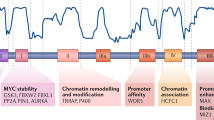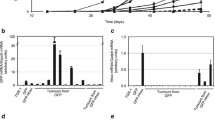Abstract
c-Myc is a cellular onco-protein and a transcriptional activator important for cell growth, cell division, and tumorigenesis. Despite all that is known of its function, the mechanism of how c-Myc contributes to tumorigenesis is unclear. To gain insight into the mechanism through which c-Myc protein exerts its oncogenic activity, we performed large-scale, tandem repeat affinity purification and identified the F box only protein 8 (FBX8), an F-box- and Sec7 domain-containing protein, as a novel Myc-binding protein. The c-Myc/FBX8 interaction was mediated by the c-Myc box II (MBII) region. We also confirmed that Myc protein overexpression in 293T cells affected FBX8 cellular translocation and led to recovery from FBX8-mediated inhibition of ADP-ribosylation factor 6 (ARF6) function during cell invasion. Together, these results suggest that FBX8 is a novel c-Myc binding protein and that c-Myc induces cell invasive activity through the inhibition of FBX8 effects on ARF6 function during cell invasion.
Similar content being viewed by others
References
Adhikary, S., and Eilers, M. (2005). Transcriptional regulation and transformation by Myc proteins. Nat. Rev. Mol. Cell Biol. 6, 635–645.
Amati, B., Dalton, S., Brooks, M.W., Littlewood, T.D., Evan, G.I., and Land, H. (1992). Transcriptional activation by the human c-Myc oncoprotein in yeast requires interaction with Max. Nature 359, 423–426.
Boshans, R.L., Szanto, S., van Aelst, L., and D’souza-Schorey, C. (2000). ADP-ribosylation factor 6 regulates actin cytoskeleton remodeling in coordination with Rac1 and RhoA. Mol. Cell. Biol. 20, 3685–3694.
Chavrier, P., and Goud, B. (1999). The role of ARF and Rab GTPases in membrane transport. Curr. Opin. Cell Biol. 11, 466–475.
Dai, M.S., Arnold, H., Sun, X.X., Sears, R., and Lu, H. (2007). Inhibition of c-Myc activity by ribosomal protein L11. EMBO J. 26, 3332–3345.
Dang, C.V. (1999). c-Myc target genes involved in cell growth, apoptosis, and metabolism. Mol. Cell Biol. 19, 1–11.
Grandori, C., Cowley, S.M., James, L.P., and Eisenman, R.N. (2000). The Myc/Max/Mad network and the transcriptional control of cell behavior. Annu. Rev. Cell Dev. Biol. 16, 653–699.
Hall, B., McLean, M.A., Davis, K., Casanova, J.E., Sligar, S.G., and Schwartz, M.A. (2008). A fluorescence resonance energy transfer activation sensor for ARF6. Anal. Biochem. 374, 243–249.
Hashimoto, S., Onodera, Y., Hashimoto, A., Tanaka, M., Hamaguchi, M., Yamada, A., and Sabe, H. (2004) Requirement for Arf6 in breast cancer invasive activities. Proc. Natl. Acad. Sci. USA 101, 6647–6652.
Hu, Z.Y., Sun, J., Zhu, X.F., Yang, D., and Zeng, Y.X. (2009). ApoG2 induces cell cycle arrest of nasopharyngeal carcinoma cells by suppressing the c-Myc signaling pathway. J. Transl. Med. 7, 74–85.
Kim, S.Y., Herbst, A., Tworkowski, K.A., Salghetti, S.E., and Tansey, W.P. (2003). Skp2 regulates Myc protein stability and activity. Mol. Cell 11, 1177–1188.
Kim, H., Chen, J., and Yu, X. (2007). Ubiquitin-binding protein RAP80 mediates BRCA1 dependent DNA damage response. Science 316, 1202–1205.
Kuttler, F., Amé, P., Clark, H., Haughey, C., Mougin, C., Cahn, J.Y., Dang, C.V., Raffeld, M., and Fest, T. (2001). c-Myc box II mutations in Burkitt’s lymphoma-derived alleles reduce cell-transformation activity and lower response to broad apoptotic stimuli. Oncogene 20, 6084–6094.
Luscher, B., and Larsson, L.G. (1999). The basic region/helix-loophelix/leucine zipper domain of Myc proto-oncoproteins: function and regulation. Oncogene 18, 2955–2966.
Lutz, W., Leon, J., and Eilers, M. (2002). Contributions of Myc to tumorigenesis. Biochim. Biophys. Acta 1602, 61–71.
Masumoto, A., Arao, S., and Otsuki, M. (1999). Role of beta1 integrins in adhesion and invasion of hepatocellular carcinoma cells. Hepatology 29, 68–74.
Mateyak, M.K., Obaya, A.J., Adachi, S., and Sedivy, J.M. (1997). Phenotypes of c-Myc-deficient rat fibroblasts isolated by targeted homologous recombination. Cell Growth Differ. 8, 1039–1048.
McMahon, S.B., Van Buskirk, H.A., Dugan, K.A., Copeland, T.D., and Cole, M.D. (1998). The novel ATM-related protein TRRAP is an essential cofactor for the c-Myc and E2F oncoproteins. Cell 94, 363–374.
Pelengaris, S., Khan, M., and Evan, G. (2002). c-MYC: more than just a matter of life and death. Nat. Rev. Cancer 2, 764–776.
Santy, L.C., Ravichandran, K.S., and Casanova, J.E. (2005). The DOCK180/Elmo complex couples ARNO-mediated Arf6 activation to the downstream activation of Rac1. Curr. Biol. 15, 1749–1754.
Sobhian, B., Shao, G., Lilli, D.R., Culhane, A.C., Moreau, L.A., Xia, B., Livingston, D.M., and Greenberg, R.A. (2007). RAP80 targets BRCA1 to specific ubiquitin structures at DNA damage sites. Science 316, 1198–202.
Tague, S.E., Muralidharan, V., and D’souza-Schorey, C. (2004). ADP-ribosylation factor 6 regulates tumor cell invasion through the activation of the MEK/ERK signaling pathway. Proc. Natl. Acad. Sci. USA 101, 9671–9676.
von der Lehr, N., Johansson, S., Wu, S., Bahram, F., Castell, A., Cetinkaya, C., Hydbring, P., Weidung, I., Nakayama, K., Nakayama, K.I., et al. (2003). The F-box protein Skp2 participates in c-Myc proteosomal degradation and acts as a cofactor for c-Myc-regulated transcription. Mol. Cell 11, 1189–1200.
Wood, M.A., McMahon, S.B., and Cole, M.D. (2000). An ATPase/helicase complex is an essential cofactor for oncogenic transformation by c-Myc. Mol. Cell 5, 321–330.
Yano, H., Kobayashi, I., Onodera, Y., Luton, F., Franco, M., Mazaki, Y., Hashimoto, S., Iwai, K., Ronai, Z., and Sabe, H. (2008). Fbx8 makes Arf6 refractory to function via ubiquitination. Mol. Biol. Cell 19, 822–832.
Author information
Authors and Affiliations
Corresponding author
About this article
Cite this article
Cho, H.J., Oh, Y.J., Kwon, J. et al. c-Myc stimulates cell invasion by inhibiting FBX8 function. Mol Cells 30, 355–362 (2010). https://doi.org/10.1007/s10059-010-0134-8
Received:
Revised:
Accepted:
Published:
Issue Date:
DOI: https://doi.org/10.1007/s10059-010-0134-8




